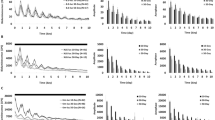Abstract
The fly brain, like the human brain, possesses an oscillatory system which enables the brain to form a model of the 24 hour cycle in the external environment. This oscillator is termed circadian, since it continues to oscillate in the absence of environmental cues with a period of about a day.1 The molecular mechanism of the circadian oscillator in any organism is as yet unknown. Since the fruit fly is an excellent organism for the study of the effects of mutations on nervous system function, chemically induced mutations affecting circadian rhythmicity were isolated.2,3 These mutations behave as alleles of a single genetic locus, per,which has been mapped by means of deletions to the 3B1-2 region of the X chromosome.2–4 They affect the periodicity of the eclosion rhythm and the adult locomotor activity rhythm in a similar manner: the short-period allele, per s,shortens the period from 24 hours in wild-type to 19 hours in the mutant; the long-period allele, per 1, lengthens the period to 29 hours; and an arrhythmic allele, per o, produces aperiodic eclosion and activity.
Access this chapter
Tax calculation will be finalised at checkout
Purchases are for personal use only
Preview
Unable to display preview. Download preview PDF.
Similar content being viewed by others
References
F. Halberg, Circadian (about twenty-four-hour) rhythms in experimental medicine,Proc. Roy. Soc. Med. 56: 253 (1963).
R. Konopka, Circadian clock mutants of Drosophila melanogaster, Ph.D. thesis, California Institute of Technology (1972).
R.J. Konopka and S. Benzer, Clock mutants of Drosophila melanogaster,Proc. Natl. Acad. Sci. USA 68: 2112 (1971).
M.W. Young and B.H. Judd, Nonessential sequences, genes and the polytene chromosome bands of Drosophila melanogaster, Genetics 88: 723 (1978).
B.H. Judd, M.W. Shen and T.C. Kaufman, The anatomy and function of a segment of the X chromosome of Drosophila melanogaster, Genetics 71: 139 (1972).
R.J. Konopka, Genetic dissection of the Drosophila circadian system, Fed. Proc. 38: 2602 (1979).
C.S. Pittendrigh, V.G. Bruce and P. Kaus, On the significance of transients in daily rhythms, Proc. Natl. Acad. Sci. USA 44: 965 (1958).
T. Pavlidis, A mathematical model for the light affected system in the Drosophila eclosion rhythm, Bull. Math. Biophysics 29: 291 (1967)
D. Njus, F.M. Sulzman and J.W. Hastings, Membrane model for the circadian clock, Nature 248: 116 (1974).
B.M. Sweeney, A physiological model for circadian rhythms derived from the Acetabularia rhythm paradoxes, Int. J. Chronobiol 2: 25 (1974).
R.F. Smith and R.J. Konopka, Genetic dosage effects at the per locus, Manuscript in preparation.
Author information
Authors and Affiliations
Editor information
Editors and Affiliations
Rights and permissions
Copyright information
© 1980 Springer Science+Business Media New York
About this chapter
Cite this chapter
Konopka, R., Orr, D. (1980). Effects of a Clock Mutation on the Subjective Day — Implications for a Membrane Model of the Drosophila Circadian Clock. In: Siddiqi, O., Babu, P., Hall, L.M., Hall, J.C. (eds) Development and Neurobiology of Drosophila . Basic Life Sciences, vol 16. Springer, Boston, MA. https://doi.org/10.1007/978-1-4684-7968-3_29
Download citation
DOI: https://doi.org/10.1007/978-1-4684-7968-3_29
Publisher Name: Springer, Boston, MA
Print ISBN: 978-1-4684-7970-6
Online ISBN: 978-1-4684-7968-3
eBook Packages: Springer Book Archive




